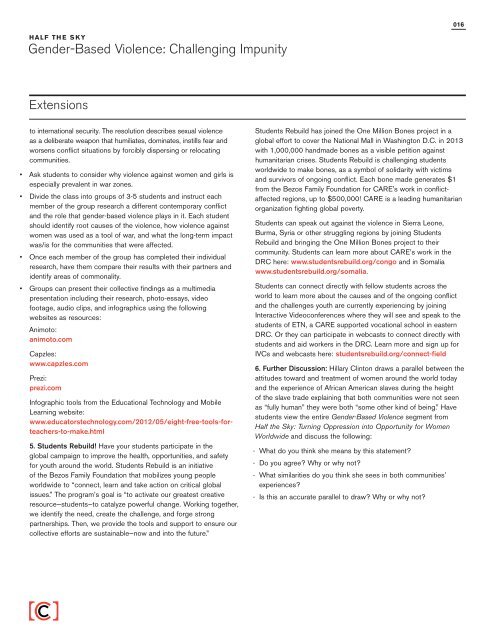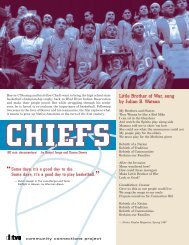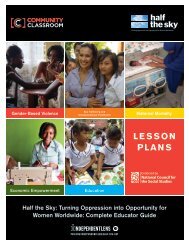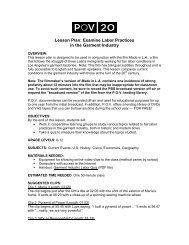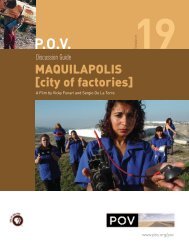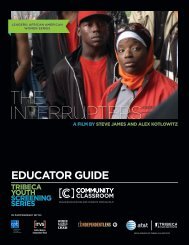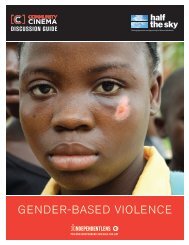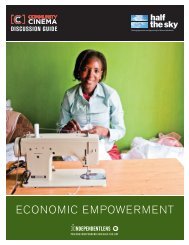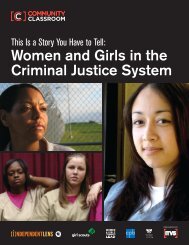Gender-Based Violence: Challenging Impunity - ITVS
Gender-Based Violence: Challenging Impunity - ITVS
Gender-Based Violence: Challenging Impunity - ITVS
You also want an ePaper? Increase the reach of your titles
YUMPU automatically turns print PDFs into web optimized ePapers that Google loves.
016<br />
HALF THE SKY<br />
<strong>Gender</strong>-<strong>Based</strong> <strong>Violence</strong>: <strong>Challenging</strong> <strong>Impunity</strong><br />
Extensions<br />
to international security. The resolution describes sexual violence<br />
as a deliberate weapon that humiliates, dominates, instills fear and<br />
worsens conflict situations by forcibly dispersing or relocating<br />
communities.<br />
• Ask students to consider why violence against women and girls is<br />
especially prevalent in war zones.<br />
• Divide the class into groups of 3-5 students and instruct each<br />
member of the group research a different contemporary conflict<br />
and the role that gender-based violence plays in it. Each student<br />
should identify root causes of the violence, how violence against<br />
women was used as a tool of war, and what the long-term impact<br />
was/is for the communities that were affected.<br />
• Once each member of the group has completed their individual<br />
research, have them compare their results with their partners and<br />
identify areas of commonality.<br />
• Groups can present their collective findings as a multimedia<br />
presentation including their research, photo-essays, video<br />
footage, audio clips, and infographics using the following<br />
websites as resources:<br />
Animoto:<br />
animoto.com<br />
Capzles:<br />
www.capzles.com<br />
Prezi:<br />
prezi.com<br />
Infographic tools from the Educational Technology and Mobile<br />
Learning website:<br />
www.educatorstechnology.com/2012/05/eight-free-tools-forteachers-to-make.html<br />
5. Students Rebuild! Have your students participate in the<br />
global campaign to improve the health, opportunities, and safety<br />
for youth around the world. Students Rebuild is an initiative<br />
of the Bezos Family Foundation that mobilizes young people<br />
worldwide to “connect, learn and take action on critical global<br />
issues.” The program’s goal is “to activate our greatest creative<br />
resource—students—to catalyze powerful change. Working together,<br />
we identify the need, create the challenge, and forge strong<br />
partnerships. Then, we provide the tools and support to ensure our<br />
collective efforts are sustainable—now and into the future.”<br />
Students Rebuild has joined the One Million Bones project in a<br />
global effort to cover the National Mall in Washington D.C. in 2013<br />
with 1,000,000 handmade bones as a visible petition against<br />
humanitarian crises. Students Rebuild is challenging students<br />
worldwide to make bones, as a symbol of solidarity with victims<br />
and survivors of ongoing conflict. Each bone made generates $1<br />
from the Bezos Family Foundation for CARE's work in conflictaffected<br />
regions, up to $500,000! CARE is a leading humanitarian<br />
organization fighting global poverty.<br />
Students can speak out against the violence in Sierra Leone,<br />
Burma, Syria or other struggling regions by joining Students<br />
Rebuild and bringing the One Million Bones project to their<br />
community. Students can learn more about CARE’s work in the<br />
DRC here: www.studentsrebuild.org/congo and in Somalia<br />
www.studentsrebuild.org/somalia.<br />
Students can connect directly with fellow students across the<br />
world to learn more about the causes and of the ongoing conflict<br />
and the challenges youth are currently experiencing by joining<br />
Interactive Videoconferences where they will see and speak to the<br />
students of ETN, a CARE supported vocational school in eastern<br />
DRC. Or they can participate in webcasts to connect directly with<br />
students and aid workers in the DRC. Learn more and sign up for<br />
IVCs and webcasts here: studentsrebuild.org/connect-field<br />
6. Further Discussion: Hillary Clinton draws a parallel between the<br />
attitudes toward and treatment of women around the world today<br />
and the experience of African American slaves during the height<br />
of the slave trade explaining that both communities were not seen<br />
as “fully human” they were both “some other kind of being.” Have<br />
students view the entire <strong>Gender</strong>-<strong>Based</strong> <strong>Violence</strong> segment from<br />
Half the Sky: Turning Oppression into Opportunity for Women<br />
Worldwide and discuss the following:<br />
--<br />
What do you think she means by this statement<br />
--<br />
Do you agree Why or why not<br />
--<br />
What similarities do you think she sees in both communities’<br />
experiences<br />
--<br />
Is this an accurate parallel to draw Why or why not


